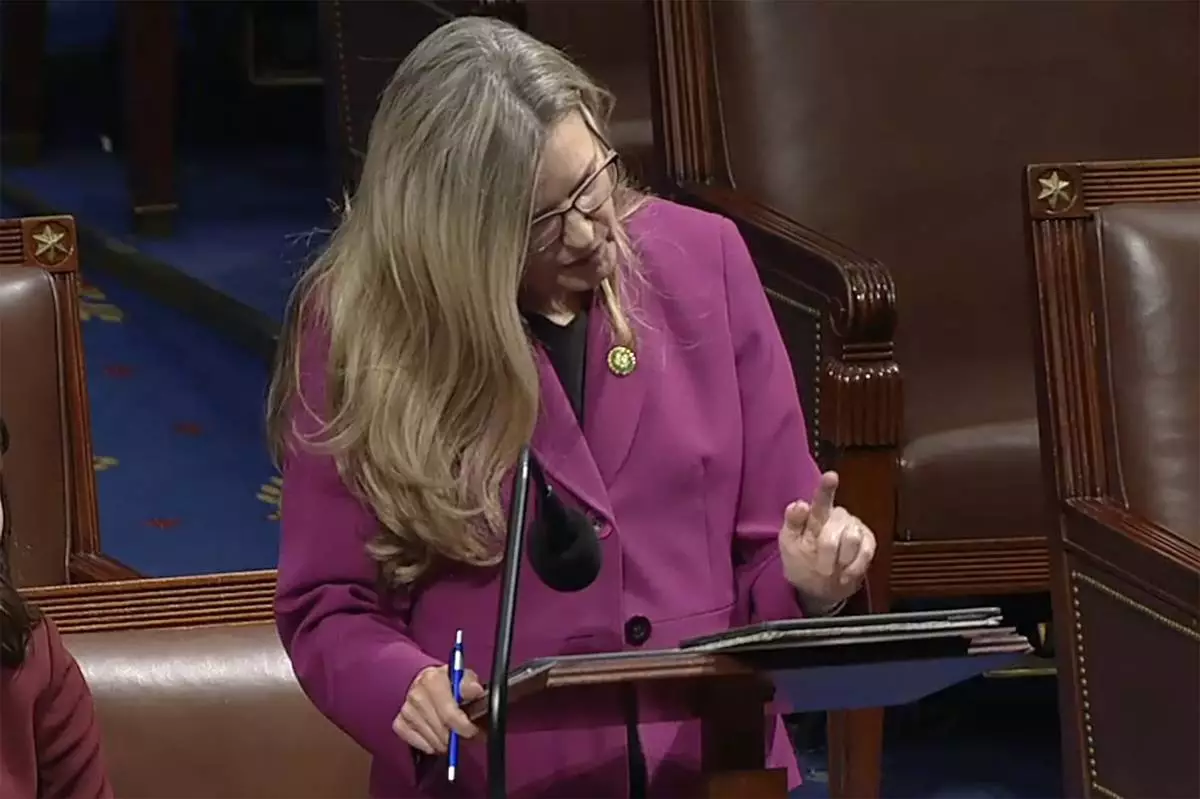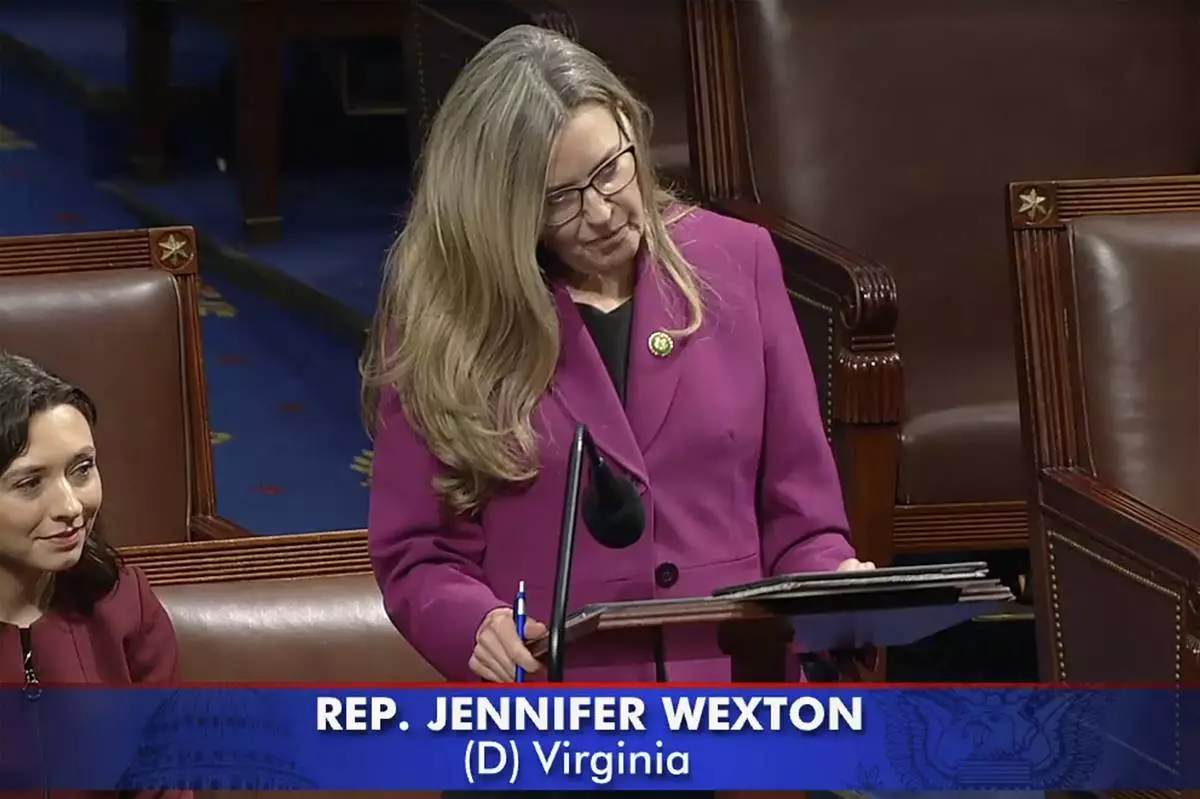When Jennifer Wexton rose Thursday to speak on the House floor, something she has done countless times before, the congresswoman used a voice she thought was gone forever.
After a rare neurological disorder robbed her of her ability to speak clearly, Wexton has been given her voice back with the help of a powerful artificial intelligence program, allowing the Virginia Democrat to make a clone of her speaking voice using old recordings of speeches and appearances she made as a congresswoman. She used that program to deliver what is believed to be the first speech on the House floor ever given via a voice cloned by artificial intelligence.
“It was a special moment that I never imagined could happen. I cried happy tears when I first heard it,” Wexton told The Associated Press in the first interview she's participated in since attaining her new voice.
Standing at a lectern on the floor, Wexton rose to commemorate Disability Pride Month, a time each July that aims to commemorate the Americans with Disabilities Act, the landmark 1990s civil rights law aimed at protecting Americans with disabilities. But her speech was also a symbol of her strength in the face of a debilitating disease.
“I used to be one of those people who hated the sound of my voice,” she remarked from the floor. “When my ads came on TV, I would cringe and change the channel. But you truly don’t know what you’ve got til it’s gone, because hearing the new AI of my old voice for the first time was music to my ears. It was the most beautiful thing I had ever heard.”
Wexton’s voice now plays out of her iPad, propped up using a rainbow-colored floral case. During the interview at her dining room table in Leesburg, Virginia, the congresswoman typed out her thoughts, used a stylus to move the text around, hit play and then the AI program put that text into Wexton’s voice. It's a lengthy process, so the AP provided Wexton with a few questions ahead of the interview to give the congresswoman time to type her answers.
Wexton was diagnosed with progressive supranuclear palsy in 2023, an aggressive neurological disorder that impacts many aspects of life, including speech. Sitting across from a credenza filled with photos marking the high points of her personal life - weddings, family trips, her children - the congresswoman called the diagnosis “cruel” for someone whose “entire professional life has been built around using my voice,” from Virginia prosecutor to state Senator to member of Congress.
“A politician who can’t do public speaking will be a former politician before too long. But this AI voice model has given me a new opportunity to have my voice heard and it reminds listeners that I am still me,” Wexton told the AP.
The congresswoman, whose runaway win in 2018 signaled the success Democrats would have that year, initially announced a Parkinson’s diagnosis in April 2023, striking an upbeat tone by telling supporters they were “welcome to empathize" with her, but not to "feel sorry for me.” Her tone in September 2023 was vastly different: She described her PSP diagnosis as “Parkinson’s on steroids” and said she would not seek reelection in 2024.
“This new diagnosis is a tough one. There is no ‘getting better’ with PSP. I’ll continue treatment options to manage my symptoms, but they don’t work as well with my condition as they do for Parkinson’s,” she said at the time.
The diagnosis has changed Wexton’s personal and professional life. The congresswoman doesn’t look like she once did. Her posture slumped, her movements less precise, her natural voice muted - all impacts of the disease. As it became more difficult for Wexton to use her voice, she turned to a traditional text-to-speech app that many people with speech disorders often use. The voice sounded more like a robot than a human, but Wexton used it to conduct interviews and give speeches.
“This is not a situation I would have chosen to find myself in,” she said from the House floor. “I never thought that at my age and otherwise good health, something like PSP could, in the space of just over a year, rob me of my ability to speak, run or dance, and force me to stop doing the job that I love.”
ElevenLabs, a start-up with one of the most widely used AI-powered voice cloning models, saw Wexton speak using the older technology. They contacted her office several weeks ago and Wexton’s aides provided the company with several recordings, mostly speeches she had given as a member of Congress.
“Our technology gives individuals who have lost their voice the ability to speak as they once did, with the emotion and passion they feel, and we hoped to help the Congresswoman do just that,” said Dustin Blank, Head of Partnerships at the company.
Wexton told AP she first used the cloned voice to speak with President Joe Biden in the Oval Office earlier this month when he signed the National Plan to End Parkinson’s Act, a bill that Wexton called the “most consequential action we have taken in decades to combat Parkinson’s and related diseases, like my PSP.” A few days later, Wexton publicly debuted her cloned voice in a video, leading to an outpouring of support and thrusting the congresswoman into a debate over AI.
This is “not the way I thought I would be leaving Congress,” she said. “I didn’t anticipate being at the forefront of a debate over the future of AI.”
Using AI-powered cloning to give Wexton her voice back is one of the positive applications of this technology. However, voice cloning has also been used nefariously, like defrauding people and pushing fake political messaging. The most notable of these instances was when an AI-generated robocall impersonating President Joe Biden urged voters ahead of the New Hampshire primary not to vote. The call was quickly reported and resulted in serious consequences for those behind it, but the incident raised serious questions about the future of this technology and the companies behind it.
Wexton, whose district is home to scores of data centers that power AI, harbors those questions, too. After she debuted her voice clone, Wexton jokingly texted a few friends the same message: “AI isn’t entirely evil, just mostly.”
Hany Farid, a professor and digital forensics expert at the University of California, Berkeley, said Wexton’s example is the exception to the numerous nefarious uses for voice cloning technology.
“I found it really moving… and I am all for this application,” he said. “But I just want to emphasize, just because there are these really beautiful stories… doesn’t mean we should just ignore the pretty nasty things with these technologies.”
One way to ensure the technology is being used for good, said Farid, is “better checks and balances” to ensure “people aren’t doing nefarious things with your products.” That includes content credentials that say how the audio was developed, storage of all audio created using the technology and know-your-customer rules that require voice cloning companies to know who is using their technology.
Wexton agrees more guardrails are needed. Her team of advisers has taken precautions to make sure her likeness is protected, from limiting access to the voice to only three people and tightening security on the program.
“It is humanizing and it is empowering. It can also be dangerous,” she said. “I still believe that the dangerous potential of AI technology must be better understood and steps must be taken to prevent abuses of the technology like deepfakes from proliferating and part of that falls on lawmakers like us in Congress," she later added.
In 2019, Wexton won bipartisan approval for an amendment directing the National Science Foundation to research public awareness around deepfake videos generated by AI.
Wexton also said the technology isn’t perfect. Because the audio used came from speeches and public events, it isn’t great for regular conversation, often making everything sound “like some big proclamation.” Her two college-aged sons, she said, don’t like it for that reason and, she quipped, she doesn’t use it to “ask my husband to please pass me the ketchup,” displaying a sense of humor that she is known for on Capitol Hill.
“At the end of the day, it will never be me. But it is more me than I ever could have hoped I could hear again and for that, I am so grateful and excited,” she said. “I plan to make the most of it.”
For doctors like Jori Fleisher, the Director of Rush CurePSP Center of Care, that sentiment is why this kind of technology could be life-altering for those diagnosed with the rare neurological disorder.
Too often PSP patients lose their voices and have to rely on traditional speech-to-text programs to communicate, Fleisher said. But those programs use robotic voices that often sound nothing like the patients. Fleisher notes that people with “neurological diseases are already stigmatized,” so speaking with a voice that sounds like a computer “perpetuates the stigma” and often leads them to withdraw from relationships and “worsens the social isolation that can be such a huge part of these conditions."
“To know of and already deeply respect Representative Wexton and then hear her speak so beautifully in her own voice, using her own words through this technology, it is giving me goosebumps now,” she said, growing emotional. “It’s so empowering.”
The key, Fleisher added, is making this technology available to more people by encouraging patients in the early stages of PSP and other neurological disorders to “bank enough sounds from your own voice that it could be used later” and for insurance companies to cover this kind of treatment. Wexton said she tried to do this late last year through an Apple program, but her voice was already too impacted by the disease for their AI to use.
Wexton’s new voice particularly helps in more emotional moments when hearing sentiment in her speech is significantly more powerful than a more robotic sound. When asked how Barbara Comstock, the Republican congresswoman Wexton has grown close to since defeating her in 2018, had helped support her since Wexton revealed her diagnosis, the Democrat grew emotional and said, “She has been so gracious.”
“I was just thrilled for her,” Comstock said, recalling when she first heard Wexton’s AI voice. “Just great to hear she is getting her literal voice out there for others to see the power of the technology. … I am getting teary thinking about it again.”
After defeating Comstock in 2018, Wexton's future in Virginia politics was bright, with many in the state speculating she could seek higher office. Her diagnosis has taken that future away — her political career will end next year — but it has given Wexton a new resolve.
“I want to be a voice, even an AI voice, for Americans facing accessibility challenges and other disabilities because too often people only see us for that disability,” Wexton said. “I hope that by continuing to do my job to the best of my ability, whether that means using a walker or a wheelchair to get to the House floor to vote or delivering my speeches through an AI-recreated version of my voice, that it can help show I am just as much me on the inside that I have always been.”
—
The Associated Press receives financial assistance from the Omidyar Network to support coverage of artificial intelligence and its impact on society. AP is solely responsible for all content. Find AP’s standards for working with philanthropies, a list of supporters and funded coverage areas at AP.org

In this image from video Rep. Jennifer Wexton, D-Va., uses an AI program on her iPad to speak in the chamber of the House of Representatives, Thursday, July 25, 2024 at the Capitol in Washington. A rare neurological disease robbed Wexton of her ability to speak clearly. But with the help of a powerful artificial intelligence program, the Virginia Democrat usee a clone of her voice to deliver what is believed to be the first speech on the House floor ever given via a voice cloned by artificial intelligence, thrusting Wexton into a broader debate about over artificial intelligence. (House Television via AP)

In this image from video Rep. Jennifer Wexton, D-Va., uses an AI program on her iPad to speak in the chamber of the House of Representatives, Thursday, July 25, 2024 at the Capitol in Washington. A rare neurological disease robbed Wexton of her ability to speak clearly. But with the help of a powerful artificial intelligence program, the Virginia Democrat usee a clone of her voice to deliver what is believed to be the first speech on the House floor ever given via a voice cloned by artificial intelligence, thrusting Wexton into a broader debate about over artificial intelligence. (House Television via AP)

In this image from video Rep. Jennifer Wexton, D-Va., uses an AI program on her iPad to speak in the chamber of the House of Representatives, Thursday, July 25, 2024 at the Capitol in Washington. A rare neurological disease robbed Wexton of her ability to speak clearly. But with the help of a powerful artificial intelligence program, the Virginia Democrat usee a clone of her voice to deliver what is believed to be the first speech on the House floor ever given via a voice cloned by artificial intelligence, thrusting Wexton into a broader debate about over artificial intelligence. (House Television via AP)













